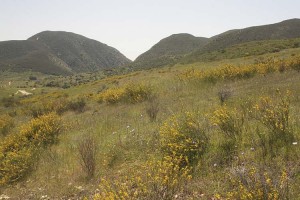On Sunday we were working outside on a project and happened to look up at the sky. A plane had been skywriting, spreading some advertising copy in the sky to the north–some sort of ad for Geico insurance, I think. After that text was done, up popped this message:
Here’s the same picture turned upside down if you’re not one of those people who read books inverted:
“Be fire safe?”
Here in San Diego we often don’t obsess about fire until after the end of summer, when the land around us has gone without water for six months and the hot desert winds blow from the east. The end of October is classic fire season for us, the time of year when the firestorms of 2003 and 2007 ravaged this part of the state. But last month’s Santa Barbara fire and this little bit of public-service skywriting got me thinking about the place of fire in the local ecosystem.

Three meetings ago, the local chapter of the California Native Plant Society hosted wildfire ecologist Richard Halsey. Director of the California Chaparral Institute, Halsey has been working to try educate the public about new understandings about fire. In addition to the institute, he’s been a strong voice in the media, and has authored the book, Fire, Chaparral and Survival in Southern California. (Town Mouse & Country Mouse did a nice post on Fire this month, which included some good quotes from Halsey.)
Anyone who thinks that plant society meetings are slow, drawn out affairs wasn’t at the meeting I attended. Halsey and one of the other biologists invited to speak went mano a mano over some of the ideas that represented a break from what is still being taught in schools.
I’m no biologist, but at least some of Halsey’s points made sense to me. Here’s a short list of some of what he had to say:
- The notion that “chaparral needs to burn” is a crock of bat guano. Although the ecosystem is adapted to coming back after a blaze, it doesn’t need fire to thrive.
- When areas burn more frequently than the plants living there are adapted to, however, many original plant species die out and invasives begin to move in. Type conversion of chaparral into a weedy grassland of exotic species can begin.
- Extensive fire breaks gouged into a natural area are a magnet for weed species that can take over the ecosystem. (See the previous bullet point.) Of all of these points, the other biologist made the strongest argument against this position of Halsey’s, citing a study where areas with abandoned fire breaks revert almost completely to their previous species after a certain number of years.
- A new study looking at ocean sediments in the Channel Islands shows that large fires have occurred in Southern California, but were separated by far greater numbers of years than we’re seeing today. Virtually all the fires we’re seeing today have been caused by humans.
- A legend of the local Kumeyaay people mentions a particularly devastating fire several hundred years before the arrival of the Spanish in California and Mexico. After the fire, the Kumeyaay had to live in the desert for an entire generation before the land west of the mountains was habitable again.
As recently as 2003-2004, when I was working a photography series on the 2003 Cedar Fire, I put together an artist’s statement for that body of work that included the sentence, “The land needed to burn, to regenerate.” Halsey has convinced me that it’s time for me to rethink that position.
 James SOE NYUN. Hill with Wildflowers, Cuyamaca Rancho State Park, 6 Months Later, 2004. Chromogenic print, 15 x 18 3/4 in.
James SOE NYUN. Hill with Wildflowers, Cuyamaca Rancho State Park, 6 Months Later, 2004. Chromogenic print, 15 x 18 3/4 in.




